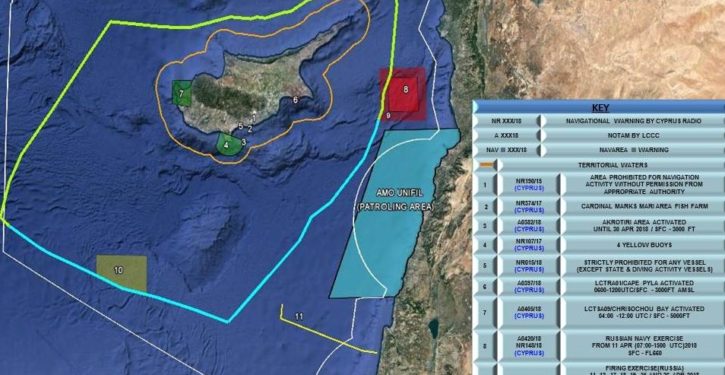
This won’t be even an attempt at a comprehensive update on the Syria situation. It’s a group of snapshots of current operations that together shed a little light on where we stand.
First of all, it does appear that U.S. forces are moving into the Eastern Mediterranean. The Washington Times reported earlier this week that four Aegis destroyers – in addition to the fifth destroyer, USS Donald Cook (DDG-75), which many readers will already have heard about – are headed for EastMed. The ships are USS Ramage (DDG-61), USS Mahan (DDG-72), USS Gravely (DDG-107), and USS Barry (DDG-52). (TWT describes them as carrying ballistic missiles, but what they mean to say is that the ships are equipped for ballistic missile defense – BMD. The ships are part of our theater BMD force.)
Maybe they’re all going. Two or three of them sounds more likely, but it could be all. The destroyers carry Tomahawk missile loads, and are otherwise optimized for air defense, airspace control, and antisurface and antisubmarine warfare. The Aegis destroyer is the backbone of the Navy. These are the guys you want for sea control in EastMed.
But they can multitask, and we mustn’t miss the likelihood that part of their purpose is to set up for theater ballistic missile defense. This would be precautionary and deterrent, in my assessment; i.e., not because there is an evident and imminent threat building.
USS Harry S Truman (CVN-75) Carrier Strike Group left Norfolk, VA on Wednesday 11 April to head to the Med and Middle East for a regularly scheduled deployment. This deployment is not in response to the Syria situation, but I’d expect Truman and at least one escort (probably the Aegis cruiser USS Normandy (CG-60)) to sprint ahead of the other escorts and reach the Strait of Gibraltar on an accelerated timeline. They could be passing the Pillars of Hercules as early as Monday 16 April.
The four strike-fighter (F/A-18) squadrons of Carrier Air Wing 1 on Truman, along with the Normandy and four Aegis destroyers – USS Arleigh Burke (DDG-51), USS Bulkeley (DDG-84), USS Forrest Sherman (DDG-98) and USS Farragut (DDG-99) – significantly boost the firepower that could be brought to bear in a Syria strike. (There’s no carrier in CENTCOM at the moment. USS Theodore Roosevelt (CVN-71) left for a return to port on the West coast a couple of weeks ago, and was in the South China Sea a couple of days ago.)
Again, however, this Truman deployment is not in response to the Syria situation. It’s a scheduled rotation movement. Its timing is convenient for carrier-based striking power to be in EastMed at a time when the president may want to use it.
Less rigorously confirmed: reports that twelve Europe-based F-16Cs (from Sigonella, Sicily and Aviano, on the Italian mainland) and – especially interesting – six A-10Cs (said to be from the 163rd Fighter Squadron, which is Indiana National Guard) have arrived at Incirlik Airbase in Turkey. (A-10s that had been at Incirlik until at least late 2017 were recently moved to Afghanistan, and I don’t think there have been A-10s at Incirlik since they left, although I haven’t been able to verify that.)
Correction: #USAF's KC-135Rs from 351st ARS, 100th ARW are dragging a combination of six A-10Cs from 163rd Fighter Squadron, 122nd Fighter Wing & twelve F-16Cs of 31st Fighter Wing from NAS Sigonella & Aviano Air Bases to #Incrilik AB to take part in Operation #InherentResolve.
— Babak Taghvaee – Μπάπακ Τακβαίε – بابک تقوایی (@BabakTaghvaee) April 11, 2018
Kind of a big deal, if valid. Meanwhile, the Navy’s P-8 Poseidon maritime reconnaissance force has been keeping busy off the Syrian coast monitoring the Russian naval exercise ginned up rapidly this week after the saber-rattling began.
On duty: USNavy Boeing P-8A (168439) from NAS Sigonella, Sicily, making surveillance mission off #Syria coast near area where today Russian navy is conducting an exercise pic.twitter.com/bwMNKSS0Ms
— Itamilradar (@ItaMilRadar) April 12, 2018
Still on duty: after a diversion to south, off Lebanon and Israeli coast, this USNavy Boeing P-8A (168439) departed this morning from NAS Sigonella, Sicily, is making again a surveillance mission off #Syria coast near area where today Russian navy is conducting an exercise pic.twitter.com/qMCCCk3mRx
— Itamilradar (@ItaMilRadar) April 12, 2018
Western media have been depicting the Russian departure from port in Tartus as the Russians fleeing in fear. A better way to frame it would be as the Russians taking the U.S. reaction seriously.
It is significant that all the naval ships reportedly got underway (although there’s no way to fully verify that), since that wouldn’t normally be the case for short-notice exercises. But the Russians have announced exercise warning areas and time periods over the week running through Monday, and that is typical and to be expected.

Russian media report the navy ships are conducting exercises off the coast, and local reporting has indicated that Russian fighter aircraft have been operating over western Syria.
The Russians appear to be drilling to defend the Syrian coast – or at least, to have a sustainable posture for tracking, trailing, and holding U.S. and allied assets at risk if we operate there. The Russians aren’t going to shoot our planes down (although they may attempt to shoot our missiles down). They’re not going to attack our warships, although they may try to interfere with their operations. (They’ve done that off Syria before, although the major instances we know about occurred in Obama’s last year in office.)
Notably, a Russian A-50 Mainstay AWACS (air command/control) aircraft was reported over western Syria and EastMed on 11 April.
https://twitter.com/BabakTaghvaee/status/984019021313036289
That’s evidence of the seriousness with which Russia views maintaining an immovable posture in Syria.
The A-50’s NATO counterpart, the E-3 Sentry, has been operating as well. This is not unusual; Operation Inherent Resolve, with its frequent strike-fighter and drone patrols in support of ground forces and interdiction targeting, has entailed the regular use of the E-3 for some time.
Surveillance mission near Turkish / Syrian border is over for this NATO Boeing E-3 (LX-N90448) now in flight back to Konya AB#Syria pic.twitter.com/HOZzUVf27T
— Itamilradar (@ItaMilRadar) April 11, 2018
Civilian news jockeys used to know more about this stuff, and not get quite so freaked out about it. We are seeing an acceleration of operating tempo on both sides – Russia and the U.S. coalition – but neither group of forces has the preparations in place to “go to war.”
Rather, what we’re seeing is a developing maneuver-and-negotiate dynamic. The media will continue to depict what’s happening as evidence that Trump has lost his mind or whatever, and there’s nothing we can do about that.
But the important thing to understand is that what’s happening, already, is the plan. That’s what it looks like to me. Trump has no intention of spinning up to a grand entry into Syria, a la Iraq 2003 or 1991. This is going to be an expeditionary influence operation.
So far, it’s having interesting results. Assad’s air force – his delivery mechanism for aerial-deployed chemical weapons – has been neutered without firing a shot. It is said to be scattering and going into hiding.
https://twitter.com/BabakTaghvaee/status/984231249056358402
The media are reflexively depicting this as the sad result of Trump’s clueless foolishness in announcing too much about his plans. The Syrian air force will be harder to find and destroy now.
But finding and destroying it may not be necessary. Neutering it, to serve an operational timeline, is a big positive step.
The T4 air base in central Syria has reportedly been largely evacuated – which assuredly is due as much to the recent, presumably Israeli missile strike as to the evidence of U.S. planning. That’s not a bad thing, or a ding on either Israel or Trump. It’s a synergistically favorable condition for the U.S. coalition (and Israel), which Assad didn’t have to bring on himself by letting Iran run riot at T4.
Assad himself, along with his family and perhaps some senior officials, is said to have moved into a bunker, or even fled the country. (I suspect Assad-actual is in the bunker.)
The operating profile and tempo of the whole Iran-Russia-Assad coalition in Syria has been disrupted – by credible threats.
Russia thinks something real is coming, and has turned the bulk of her attention to the potential threat from outside Syria. Russia has also reportedly requested a meeting of the UN Security Council on Friday 13 April – a signal that the Russians suddenly see a need to put down markers, get some diplomatic noise going, and try to maintain some stakeholder control of where this is headed.
That’s great. And since the Russian posture on Syria a week ago was “out of our face, we own this joint,” it’s a significant shift.
For conditions to favor serious negotiation and a meaningful settlement in Syria, the first turning has to be from Russia. I don’t know if it will be possible to keep egging Moscow toward a more cooperative posture with persistent pressure and threats. But putting pressure on Iran, which unquestionably has to be done, won’t be effective as long as Patron Russia’s attitude hasn’t changed.
There may be strikes. We’ll see. Truman & Co will be there in a few days. B-2s from Whiteman can be there in hours, as can Air Force strike-fighters from Europe. Tomahawks can be there in minutes.
But the “information” value of visibly planning and preparing is already having an effect. What we see is not chaos or inconsistency but deliberate military operations in support of a developing political objective. There may not be a good analogue — “Iraq,” “Afghanistan,” other previous GWOT ops, or even further back to things like the Balkans, Somalia, or the Cold War — to this emerging operation.
And that can be a political problem, no question. I always favor more suasion up front: more clear statements of national interests and objectives. I definitely favor explaining to Congress and the people what this is about. Whatever the Syria operation turns into, it will be beyond the scope of the War on Terror Authorization for the Use of Military Force – a point that badly needs a formal resolution in Congress. I don’t expect to lose the urge to criticize Trump’s M.O. in that regard.
But I’ve watched him long enough to figure out that he isn’t trying to do something we all expect, but in an incompetent way. He’s got something else in mind. Look with the eyes of analysis and you’ll see it.
Sad note for our NATO ally Greece, which lost a Mirage 2000 fighter and pilot over the Aegean on 12 April.
Remains of Greek mirage jet found off Skyros, according to Hellenic Air Force, pilot confirmed dead. https://t.co/22CS8opSYB via @ekathimerini #Balkans pic.twitter.com/UT4hlRvojm
— Liveuamap (@Liveuamap) April 12, 2018
Our deepest condolences.



